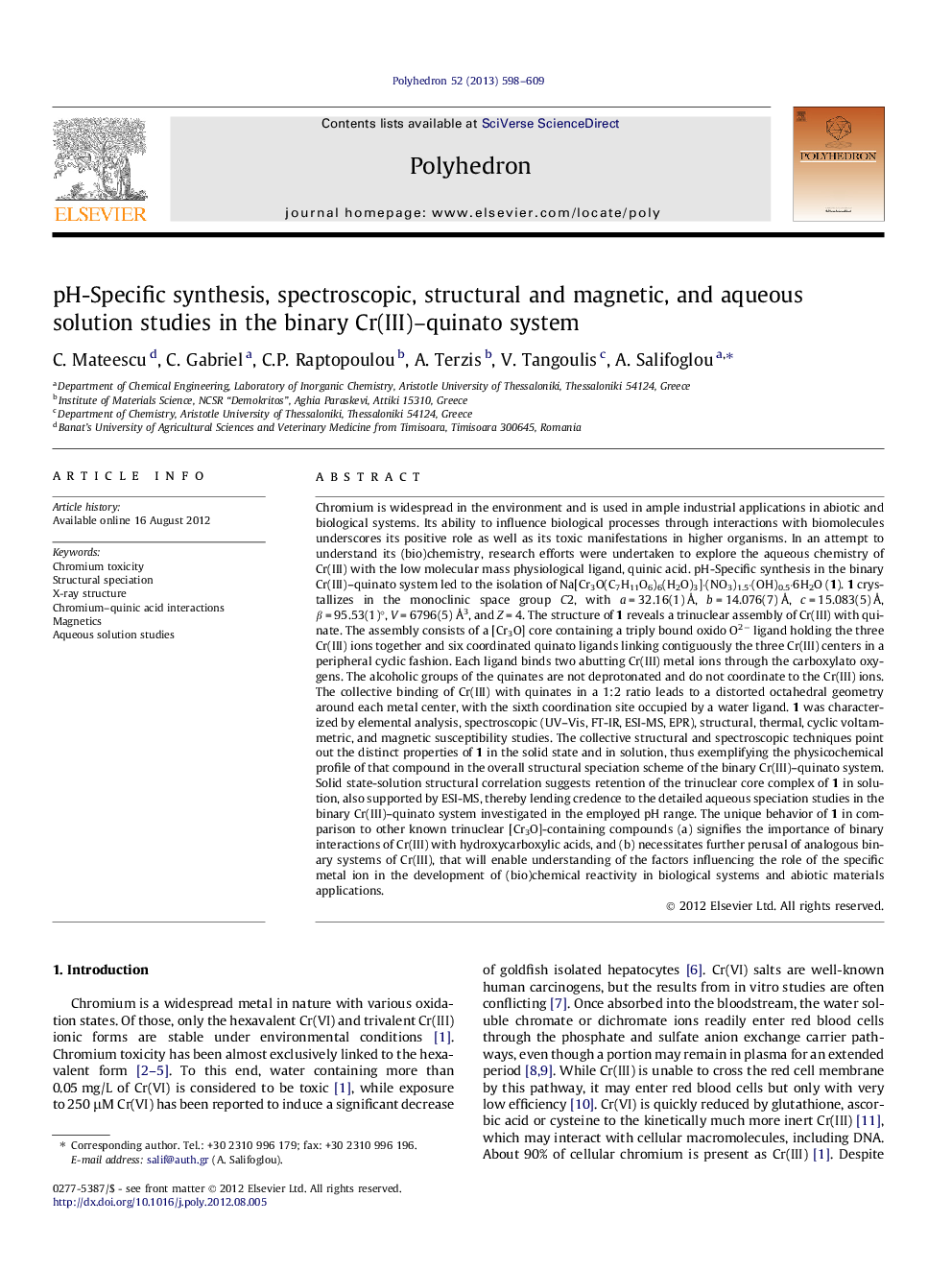| کد مقاله | کد نشریه | سال انتشار | مقاله انگلیسی | نسخه تمام متن |
|---|---|---|---|---|
| 1336989 | 1500287 | 2013 | 12 صفحه PDF | دانلود رایگان |

Chromium is widespread in the environment and is used in ample industrial applications in abiotic and biological systems. Its ability to influence biological processes through interactions with biomolecules underscores its positive role as well as its toxic manifestations in higher organisms. In an attempt to understand its (bio)chemistry, research efforts were undertaken to explore the aqueous chemistry of Cr(III) with the low molecular mass physiological ligand, quinic acid. pH-Specific synthesis in the binary Cr(III)–quinato system led to the isolation of Na[Cr3O(C7H11O6)6(H2O)3]·(NO3)1.5·(OH)0.5·6H2O (1). 1 crystallizes in the monoclinic space group C2, with a = 32.16(1) Å, b = 14.076(7) Å, c = 15.083(5) Å, β = 95.53(1)°, V = 6796(5) Å3, and Z = 4. The structure of 1 reveals a trinuclear assembly of Cr(III) with quinate. The assembly consists of a [Cr3O] core containing a triply bound oxido O2− ligand holding the three Cr(III) ions together and six coordinated quinato ligands linking contiguously the three Cr(III) centers in a peripheral cyclic fashion. Each ligand binds two abutting Cr(III) metal ions through the carboxylato oxygens. The alcoholic groups of the quinates are not deprotonated and do not coordinate to the Cr(III) ions. The collective binding of Cr(III) with quinates in a 1:2 ratio leads to a distorted octahedral geometry around each metal center, with the sixth coordination site occupied by a water ligand. 1 was characterized by elemental analysis, spectroscopic (UV–Vis, FT-IR, ESI-MS, EPR), structural, thermal, cyclic voltammetric, and magnetic susceptibility studies. The collective structural and spectroscopic techniques point out the distinct properties of 1 in the solid state and in solution, thus exemplifying the physicochemical profile of that compound in the overall structural speciation scheme of the binary Cr(III)–quinato system. Solid state-solution structural correlation suggests retention of the trinuclear core complex of 1 in solution, also supported by ESI-MS, thereby lending credence to the detailed aqueous speciation studies in the binary Cr(III)–quinato system investigated in the employed pH range. The unique behavior of 1 in comparison to other known trinuclear [Cr3O]-containing compounds (a) signifies the importance of binary interactions of Cr(III) with hydroxycarboxylic acids, and (b) necessitates further perusal of analogous binary systems of Cr(III), that will enable understanding of the factors influencing the role of the specific metal ion in the development of (bio)chemical reactivity in biological systems and abiotic materials applications.
Aqueous reactions of Cr(III) with quinic acid (pH ∼3) led to the isolation of a new compound Na[Cr3O(C7H11O6)6(H2O)3]·(NO3)1.5·(OH)0.5·6H2O (1). 1 was characterized by analytical, spectroscopic (UV–Vis, FT-IR, ESI-MS, EPR) techniques, electrochemistry, magnetics, TGA–DTG, and X-ray crystallography. The collective physicochemical properties of 1 and solution studies in the binary Cr(III)–quinato system formulate its solid state-solution profile and shed light on Cr(III) reactivity in abiotic and biological processes.Figure optionsDownload as PowerPoint slide
Journal: Polyhedron - Volume 52, 22 March 2013, Pages 598–609